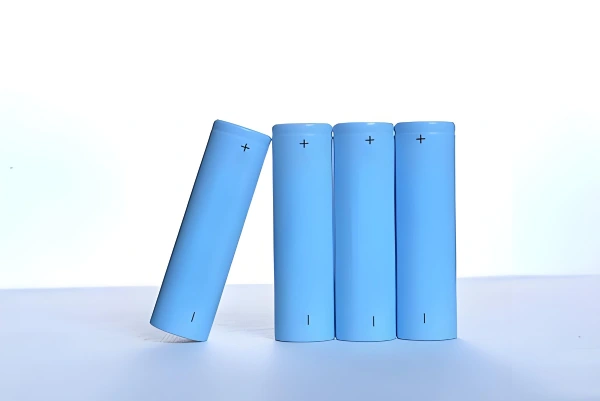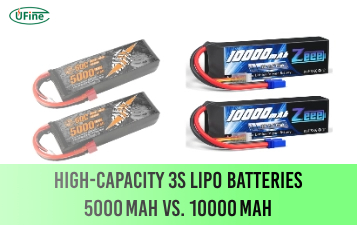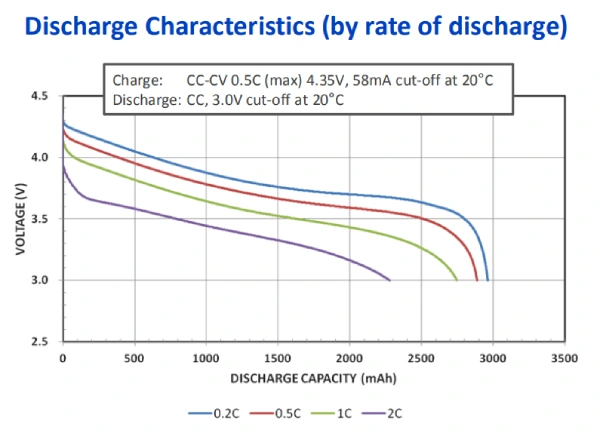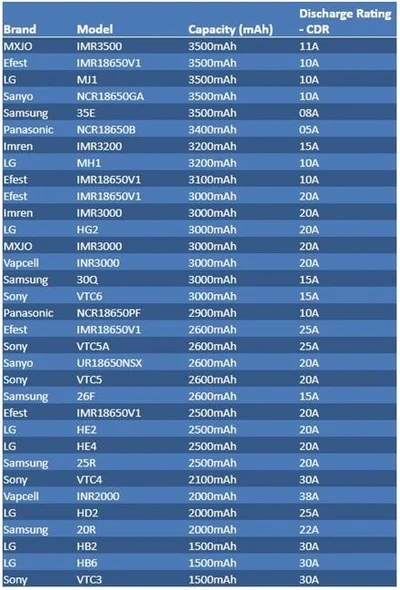Part 1. What does 18650 capacity mean?

The 18650 capacity refers to the charge it can store and deliver. It is typically measured in milliampere-hours (mAh) or ampere-hours (Ah). The 18650 capacity indicates how long the battery can sustain a given current draw before recharging.
For example, suppose an 18650 battery has a capacity of 3000mAh. In that case, it theoretically means it can deliver a current of 3000 milliamperes (or 3 amperes) for one hour before reaching its fully discharged state.
Alternatively, the battery can last longer if the current draw is lower.
For instance, if the device draws 500mA, the same 3000mAh battery would last approximately 6 hours (3000mAh ÷ 500mA = 6 hours).
Higher capacity 18650 batteries can store more charge, resulting in longer runtime for devices powered by these batteries.
Part 2. How to check the 18650 capacity?
Here’s a step-by-step guide to checking the 18650 capacity:
- Identify the Battery: Make sure you have an 18650 battery. Look for the label or markings on the battery to confirm its size and type.
- Use a Multimeter (Voltage Method): Set your multimeter to the voltage appropriate for the battery (usually DC voltage). Check the voltage of the fully charged battery. A fully charged 18650 battery typically reads around 4.2 volts.
- Discharge the Battery: Use a battery discharge tester or device to draw a consistent load from the battery. Discharge the battery completely until the voltage drops to around 3.0 volts, the recommended cutoff voltage for lithium-ion batteries to prevent damage.
- Measure the Discharged Voltage: Once discharged, measure the 18650 battery voltage again using the multimeter. Note the voltage reading.
- Calculate Capacity: The capacity of the battery can be calculated using the formula: Capacity (mAh) = Discharged Voltage (V) × Capacity Constant (mAh/V). The capacity constant for 18650 batteries is usually around 1000mAh/V. For example, if the voltage drops from 4.2 volts to 3.0 volts during discharge, the capacity can be calculated as (4.2V – 3.0V) × 1000mAh/V = 1200mAh.
- Verify Results: Compare the calculated capacity with the manufacturer’s specified capacity (if available) or with similar batteries of known capacity to verify the accuracy of your measurement.
Part 3. What is the 18650 capacity range?
The 18650 battery capacity range can vary depending on the specific chemistry, manufacturer, and intended use.
Generally, the 18650 capacity range falls within the range of approximately 1000mAh to 3500mAh. However, it’s important to note that there are exceptions, and some specialty or high capacity 18650 batteries can exceed this range.
However, here’s a general overview of the typical 18650 capacity range you might encounter:
- Low Capacity 18650: Around 1000mAh to 2000mAh
- Medium Capacity 18650: Around 2000mAh to 3000mAh
- High Capacity 18650: Around 3000mAh to 3500mAh or more
Part 4. High capacity 18650 battery vs. low capacity 18650 battery
Here’s a comparison between high capacity and low capacity 18650 batteries:
High Capacity 18650 Battery:
- Greater Energy Storage: High capacity 18650 batteries typically have a larger energy storage capacity, often ranging from 3000mAh to 3500mAh or more.
- Longer Runtime: High capacity 18650 can power devices for longer durations before needing to be recharged or replaced
- Suitable for High-Drain Devices: High capacity batteries are well-suited for devices with high power demands.
- Bulkier: Due to their larger capacity, high capacity 18650 batteries may be slightly bulkier and heavier than lower capacity options.
- Higher Cost: Typically, high capacity batteries may come at a higher price point compared to lower capacity ones due to the increased energy storage capacity.
Low Capacity 18650 Battery:
- Smaller Energy Storage: Low capacity 18650 batteries have a smaller energy storage capacity, often ranging from 1000mAh to 2000mAh.
- Shorter Runtime: High capacity 18650 provides shorter usage times before needing to be recharged or replaced.
- Compact and Lightweight: Due to their lower capacity, 18650 batteries are usually more compact and lightweight.
- Lower Cost: Low capacity 18650 batteries tend to be more affordable than high capacity options.
- Less Suitable for High-Drain Devices: Low capacity 18650 batteries may not be suitable for devices with high power demands or continuous high-drain applications.
Part 5. What the 18650 maximum capacity?
If given a choice, everyone would choose the highest capacity 18650 battery. 18650 Capacity is measured in milliamp hours (mAh). This tells us how many milliamps of current can be drawn from the battery and for how long.
However, 18650 capacity comes at the expense of the current rating (CDR). Each 18650 cell can only hold a certain amount of material inside. So you usually must choose between the 18650 maximum capacity or a high current battery.
Currently, most 18650 lithium batteries on the market have capacities between 2200-3500mAh. The 18650 lithium battery in this capacity range has the best stability and consistency.
In recent years, some battery manufacturers have improved battery technology and production capacity. The 18650 maximum capacity of Samsung, Panasonic, LG, Sony, and Toshiba can reach more than 3600mAh.
But as of 2021, there is no 18650 battery with a rated capacity of more than 3600mAh or 30A CDR. Suppose you see any 18650 batteries on the market that are above these specs. In that case, you should be very sick of what you are getting, as it is certainly fake and exaggerated.
Part 6. Top 3 highest capacity 18650 batteries
There are three main manufacturers that produce and manufacture the highest capacity 18650 batteries. These battery manufacturers are Panasonic, LG, and Samsung SDI.
| Brand | Type | Dimension | Nominal capacity | Nominal voltage | Maximum voltage | Discharge current |
|---|---|---|---|---|---|---|
| Panasonic | NCR18650G | 18650 | 3600mAh | 3.6V | 4.2V | Maximum continuous 4.87A |
| LG | INR18650-M36 | 18650 | 3600mAh | 3.6V | 4.2V | Maximum continuous 10A |
| Samsung SDI | INR18650-36G | 18650 | 3600mAh | 3.6V | 4.2V | 10A maximum continuous current |
Part 7. FAQs
-
Do higher capacity 18650 batteries last longer?
Yes, higher capacity batteries can provide longer runtime before requiring a recharge compared to lower capacity ones. -
Are higher capacity 18650 batteries larger in size?
Generally, yes. Higher capacity batteries may have larger physical dimensions due to increased active material. -
Are high capacity 18650 batteries suitable for all devices?
No, high capacity batteries may not be compatible with devices that have limited space or require lower power output. -
Are lower capacity 18650 batteries less expensive?
Lower capacity batteries are generally more cost-effective than their higher capacity counterparts. -
Can I use high capacity 18650 batteries in low-power devices?
Yes, you can use high capacity batteries in low-power devices, but they may provide longer runtime than necessary. -
Do higher capacity 18650 batteries require special chargers?
No, higher capacity batteries can be charged using standard 18650 battery chargers. -
Can I replace my device with a lower capacity battery with a higher capacity battery?
In most cases, yes. However, ensure that the physical size and voltage of the higher capacity battery are compatible with your device. -
Are there any safety concerns with high capacity 18650 batteries?
High capacity batteries, like any other lithium-ion batteries, should be used cautiously and in accordance with safety guidelines to prevent risks such as overheating or over-discharging. -
Are there 18650 batteries with capacities higher than 3500mAh?
Yes, some 18650 batteries may exceed 3500mAh, but they are less common and may have specific applications. -
Do higher capacity 18650 batteries always provide better performance?
Not necessarily. Factors like discharge rate and overall quality also impact performance, not just capacity. -
Is there a risk of overloading my device with a high-capacity battery?
Not necessarily, as long as the voltage and discharge rate of the battery are within the device’s specifications. -
How many charge cycles can I expect from a high-capacity 18650 battery?
High-quality batteries may endure 300 to 500 charge cycles or more, but this can vary based on usage and maintenance.
Related Tags:
More Articles

High‑Capacity 3S LiPo Batteries: 5000 mAh vs. 10000 mAh
Compare 3S LiPo 5000mAh vs 10000mAh batteries by weight, power, and use. Find the best fit for your drone, RC car, or boat setup.
Top 5 Applications for Small 3S LiPo Batteries
Small 3S LiPo batteries power drones, RC gear, wearables, and robotics with high energy and low weight. Making them ideal for compact electronics projects.
Building and Charging Your Own 3S LiPo Pack: A Step‑by‑Step Guide
Learn how to build, balance, and charge a 3S LiPo battery pack safely at home with this complete DIY guide for hobbyists and beginners.
How to Choose the Right LiPo Battery Plug Type?
Discover the best LiPo battery plug types, how to choose them, and expert tips for safe usage, soldering, and maintenance.
Choosing the Right Connector for Your 3S LiPo Battery
Choosing the right 3S LiPo connector depends on current, space, and use. Learn the pros and cons of XT60, JST, EC3, and more.





